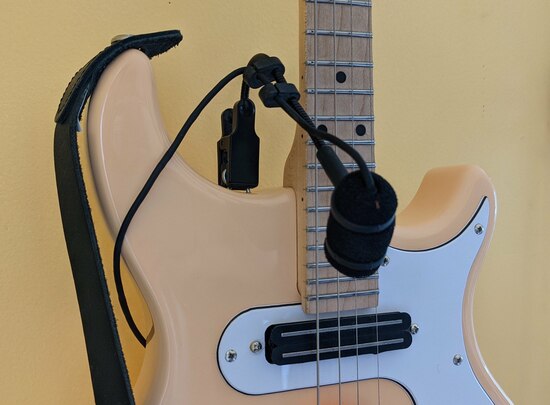A large portion of what I'm doing when I play rhythm mandolin is percussive: the sound of the pick hitting the strings. After listening back to the comparison between my electric and acoustic mandolins, this is the thing I find most lacking in the sound of the electric. What's interesting, however, is that I don't really notice this when playing at home. I realized a few days ago that it's hearing the electric mandolin acoustically that makes the difference, because the pickups are not really capturing these pick sounds. And if I can hear it acoustically, I can fix it with a microphone!
I made some recordings, and I really like the sound I get when I mix a little external microphone into the main sound from the pickup. I also really like that this means when I run the pickups through distortion or a talkbox the crisp sound of the percussion is unaffected.
Here's what it sounds like, recorded on an AudioBox VSL1818. The clip-on mic is an Audio-Technica Pro-35. In cases where I recorded the same thing last time, I've included the acoustic version for comparison. I've also included EvanY's EQ-matched versions from last time.
Overall, I feel like this is a huge improvement for chords and other percussive things, while it doesn't have much of an impact on melody either way.
Chords
( pickup only mp3)
( dual mp3)

( acoustic mp3)

( Logic EQ-matched mp3)

( Pro-Q EQ-matched mp3)

More Chords
( pickup only mp3)
( dual mp3)

Percussive
( pickup only mp3)
( dual mp3)

High Riff
( pickup only mp3)
( dual mp3)

( acoustic mp3)

Low Riff
( pickup only mp3)
( dual mp3)

( acoustic mp3)

High Melody
( pickup only mp3)
( dual mp3)

( acoustic mp3)

Medium Melody
( pickup only mp3)
( dual mp3)

( acoustic mp3)

Low Melody
( pickup only mp3)
( dual mp3)

( acoustic mp3)

I'm happy with this, and while this doesn't get the sound of the electric to where I would leave the acoustic behind on a Free Raisins gig, I think it will help Kingfisher mandolin sets a lot.
Comment via: facebook
